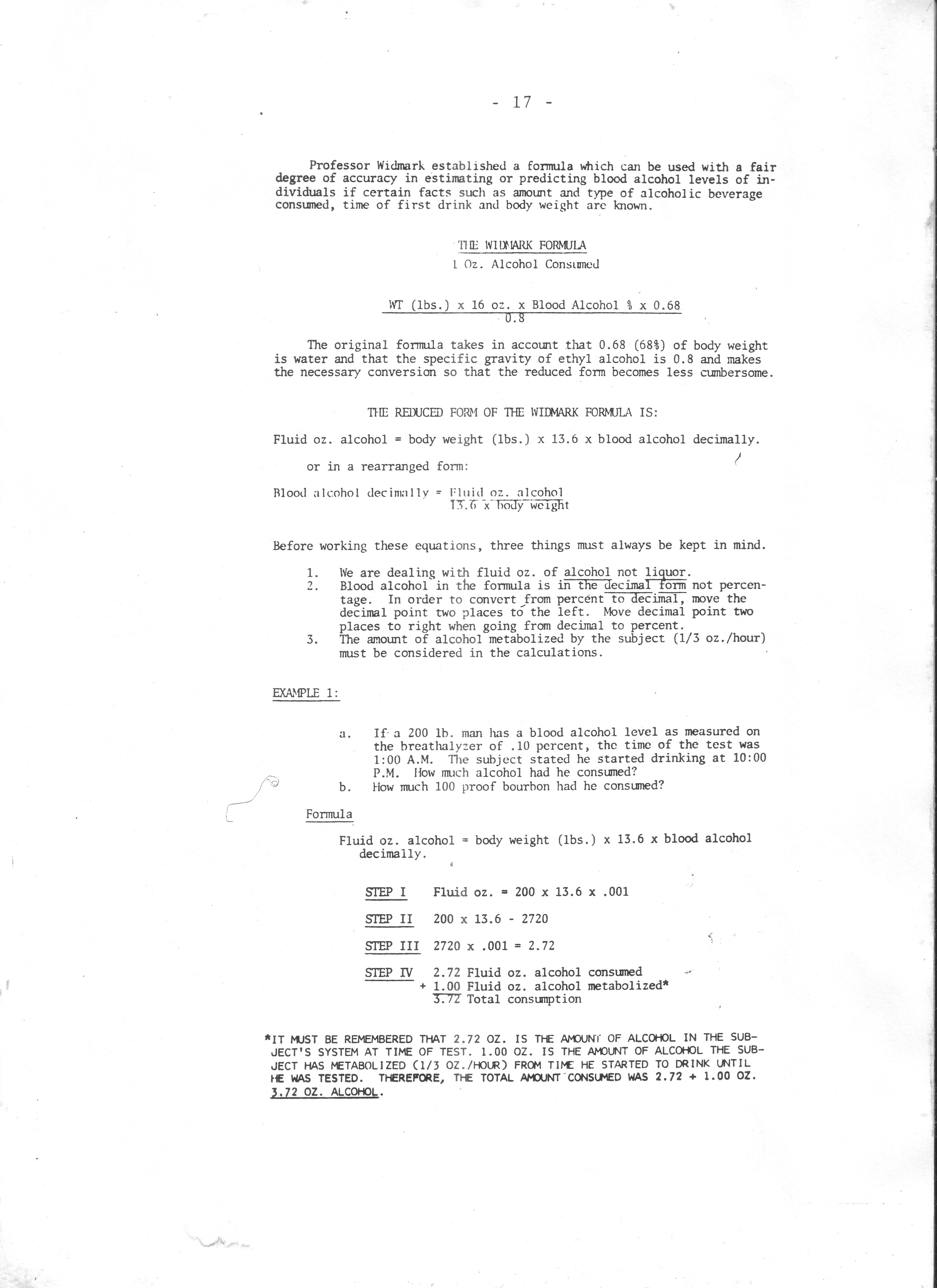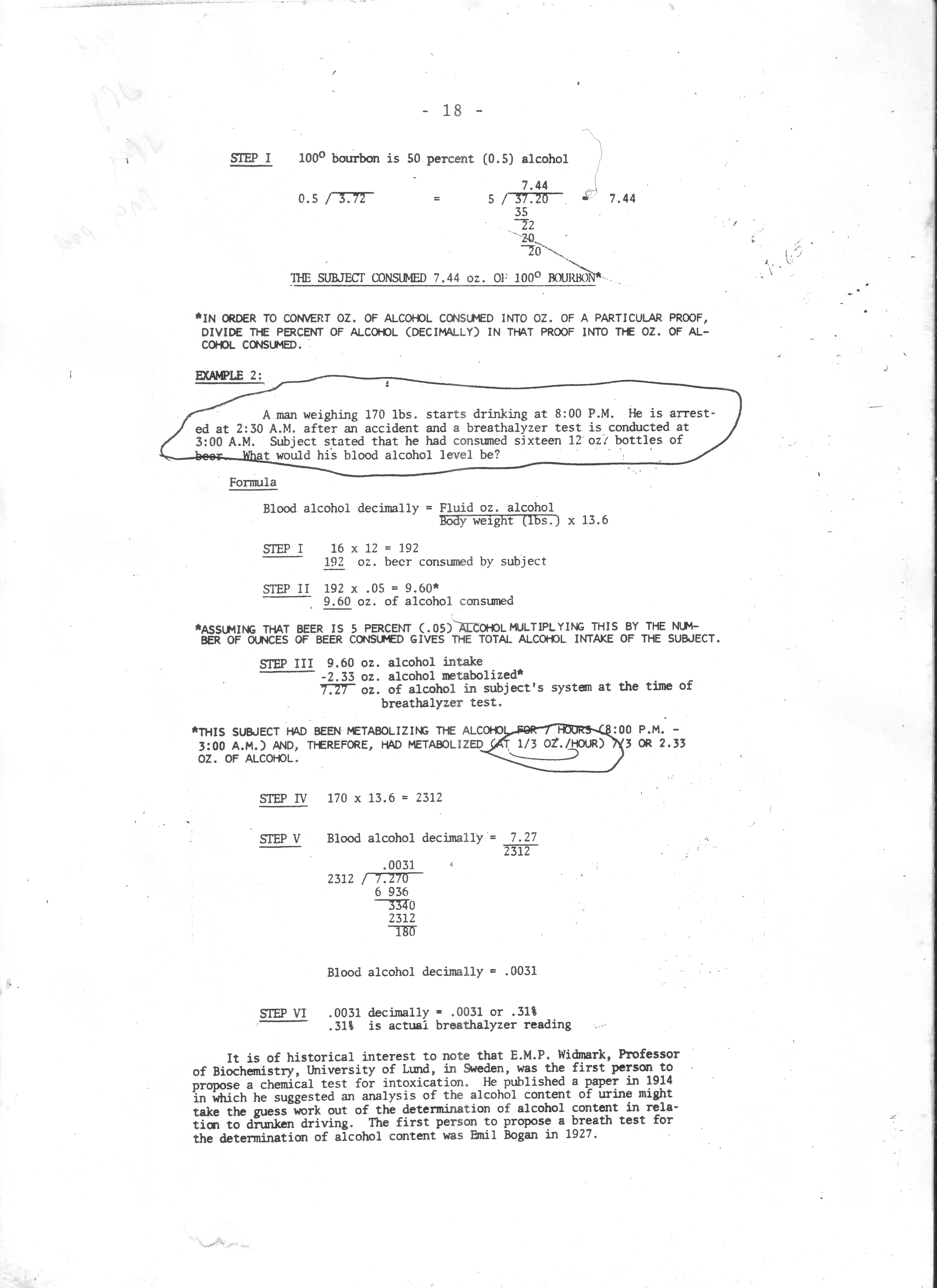Since this is my web site, I guess I can use some editorial license and post a couple of pages from my text that was used in my training at the University of Rhode Island School of Pharmacology. In the below pages there might be some notes visible. I put them there during my studies and please disregard them. The below description of the Widmark Formula is rather well developed and easy to follow.
Although simple it might be hard to read so I will type it here
BAC = Fluid Oz EtOH - (hrs. x .333) / 13.6 x Body Weight
The above BAC x 100 will give you BAC % w/v
This was not the "Original" Widmark Formula, and below is the development of the formula which using some algebra gives one the above simplified formula. Try the original Widmark formula, add the modification by ME and then enter the same data into the above formula and the result will be the same.
The only caveat is the use of Fluid Oz of Alcohol. As the text above describes. One must convert consumption of a beverage to the actual fluid ounces of alcohol. In the example above the text describes that sixteen 12 oz bottles of beer. Since 5% is representative as to typical U.S. Larger beers sixteen 12 oz beers will have 192 oz of beer x .05 per weight = 9.6 Fl. oz of Alcohol. You would use 9.6 oz of alcohol in the program.
Also, remember to remove the amount of alcohol that is metabolized (catabolized). The example says that the subject drank from 8:00 PM to 2:00 AM so that subject consumed beer for 7 hours. Since we know that the human body catabolizes EtOH at a rate of .3 oz per hour the subject lost 2.33 oz of EtOH. There at the time of test the subject had 7.27 oz EtOH on board. 9.6 oz consumed over 7 hours minus 2.33 oz catabolized = 7.27 EtOH on board.
With a known body weight times the factor of 13.6 divided into the amount of EtOH on board at the time of interest one can calculate the subjects BAC.
The original formula dealt with the weight of EtOH. Each Fl.oz. of Pure EtOH weighs 0.0514. When Widmak developed his formula he theorized and eventually proved that only about 68% of a person's body weight actually can "hold" or "retain" alcohol. In women it is slightly more. Widmark called this his 'r'factor.
From the time Widmark wrote his theses up until about 1987, this formula was scientifically accepted as being accurate.
Fl. oz. EtOH x 0.0514 x weight / fl. oz. EtOH. = lbs of EtOH
Therefore, the original Widmark Formula is a follows:
BAC = Fl oz EtOH x 0.0154 x weight/fl oz EtOH x 100% all divided by weight x 0.68
In 1987 Fitzgerald & Hume pointed out that the specific gravity of blood (1.055g/ml must be included in the denominator. Adding the factor, show Widmark's formula in full.
BAC% w/v = Floz EtOH x 0.0514 x weight/floz EtOH x100% x 1.055g/ml all divided by Pounds of person x Widmark r. The BAC g%/ml = BACg g/dL=BAC% w/v.
This formula was fine until the controlled experiments showed that the subject had denigration or catabolism (metabolism) of EtOH over a period of time. A constant of 1/3 oz or alcohol per hour is scientifically accepted as being accurate.
So, I will modify Widmark by the following:
BAC% W/V = Fl oz EtOH x 0.0154 x 100% x 1.055g/ml all divided by Pounds of person x Widmark r - (hrs of consumption x .333) The BAC% g/ml =BAC% g/dL = BAC% w/v
The above formula and the "straight line" formula I use will give the same results without doing all the complicated math.
RETUN TO THE TOPIC SECTION OF THIS AREA

